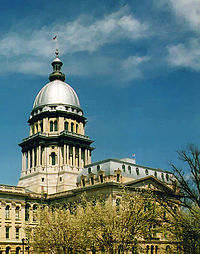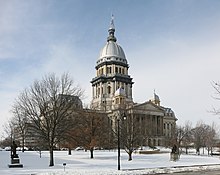Illinois General Assembly: Difference between revisions
Zero Thrust (talk | contribs) m →History |
|||
| Line 43: | Line 43: | ||
Members of the House of Representatives are elected to a two-year term without [[term limits in the United States|term limits]]. |
Members of the House of Representatives are elected to a two-year term without [[term limits in the United States|term limits]]. |
||
The term cycle for the Illinois Senate is staggered. To avoid complete turnovers in membership (except after an intervening Census), not all districts elect senators simultaneously. Every Senate district elects its members to serve two four-year terms and one two-year term per decade. The placement of the two-year term in the decade varies from one district to another, with each district's terms defined as 2-4-4, 4-2-4, or 4-4-2. |
The term cycle for the Illinois Senate is staggered. To avoid complete turnovers in membership (except after an intervening Census), not all districts elect senators simultaneously. Every Senate district elects its members to serve two four-year terms and one two-year term per decade. The placement of the two-year term in the decade varies from one district to another, with each district's terms defined as 2-4-4, 4-2-4, or 4-4-2. Like House members, Senators are elected without term limits. |
||
==Officers== |
==Officers== |
||
Revision as of 03:22, 15 September 2013
Illinois General Assembly | |
|---|---|
 | |
| Type | |
| Type | |
| Houses | Senate House of Representatives |
| Leadership | |
| Structure | |
| Seats | 177 |
Political groups | Democratic Party Republican Party |
| Elections | |
Last election | November 6, 2012 |
| Meeting place | |
 | |
| Illinois State Capitol, Springfield | |
| Website | |
| http://www.ilga.gov | |
The Illinois General Assembly is the state legislature of the U.S. state of Illinois and comprises the Illinois House of Representatives and the Illinois Senate. The General Assembly was created by the first state constitution adopted in 1818. The state senate has 59 members while the House has 118. A Senate district is formed by combining two House districts. The current General Assembly is Illinois's 98th.
The General Assembly meets in the Illinois State Capitol in Springfield, Illinois.
History
The Illinois General Assembly was created by the first state constitution adopted in 1818. Initially, the state did not have organized political parties, but the Democratic and Whig parties began to form in the 1830s.
Future President Abraham Lincoln successfully campaigned to serve in the General Assembly in 1834, running as a Whig. He won election to the state legislature; though he ran as a Whig.[1] He served four successive terms in the Illinois House of Representatives, supporting expanded suffrage and the abolition of slavery.
The Illinois Republican Party was organized at a conference held in Major's Hall in Bloomington, Illinois on May 29, 1856. Its founding members came from the former Whig Party in Illinois after its members joined with several powerful local political factions including, notably, the Independent Democrat movement of Chicago that helped elect James Hutchinson Woodworth as mayor in 1848.
During the election of 1860 in which Lincoln was elected president, Illinois also elected a Republican governor and legislature, but the trials of war helped return the state legislature to the Democratic Party of Illinois in 1861.[2] The Democratic Party-led legislature investigated the state's war expenditures and the treatment of Illinois troops, but with little political gain.[2] They also worked to frame a new state constitution that gave the southern portion of the state increased representation and included provisions to discourage banking and the circulation of paper currency.[2] Voters rejected each of the constitution's provisions, except the bans on black settlement, voting and office holding.[2] The Democratic Party came to represent skepticism in the war effort, until Illinois' Democratic leader Stephen A. Douglas changed his stance and pledged his full support to Lincoln.[2]
The Democratic Party swept the 1862 election.[2] They passed resolutions denouncing the federal government's conduct of the war and urging an immediate armistice and peace convention in the Illinois House of Representatives, leading the Republican governor to suspend the legislature for the first time in the state's history.[2]
In 1864, Republicans swept the state legislature and at the time of Lincoln's assassination at Ford's Theater, Illinois stood as a solidly Republican state.[2]
By the 1990s, Illinois had started to become more Democratic in state elections, in a large part because the GOP's Southern Strategy had alienated many Northeastern and Midwestern Republican voters. In 1994, the Democratic Party gained control of the Illinois House of Representatives. Next, a Democratic candidate became Illinois governor for the first time in 26 years and Democrats gained control over the Illinois Senate. With the exception of 2010, Illinois Democrats have consistently gained more and more power in every election year in Illinois since the mid-1990s.
Terms of members
Members of the House of Representatives are elected to a two-year term without term limits.
The term cycle for the Illinois Senate is staggered. To avoid complete turnovers in membership (except after an intervening Census), not all districts elect senators simultaneously. Every Senate district elects its members to serve two four-year terms and one two-year term per decade. The placement of the two-year term in the decade varies from one district to another, with each district's terms defined as 2-4-4, 4-2-4, or 4-4-2. Like House members, Senators are elected without term limits.
Officers
The officers of the General Assembly are elected at the beginning of each even number year. Representatives of the House elect from its membership a Speaker and Speaker pro tempore, drawn from the majority party in the chamber. The Illinois Secretary of State convenes and supervises the opening House session and leadership vote. State senators elect from the chamber a President of the Senate, convened and under the supervision of the governor. Since the adoption of the current Illinois Constitution in 1970, the Lieutenant Governor of Illinois does not serve in any legislative capacity as Senate President, and has had its office's powers transferred to other capacities.
Sessions and qualifications
The General Assembly's first official working day is the second Monday of January each year, with the Secretary of State convening the House, and the governor convening the Senate.[3] In order to serve as a member in either chamber of the General Assembly, a person must be a U.S. citizen, at least 21 years of age, and for the two years preceding his election or appointment a resident of the district which they represent.[3] In the general election following a redistricting, a candidate for any chamber of the General Assembly may be elected from any district which contains a part of the district in which he resided at the time of the redistricting and reelected if a resident of the new district he represents for 18 months prior to reelection.[3]
Restrictions
Members of the General Assembly may not hold other public offices or receive appointments by the governor, and their salaries may not be increased during their tenure.[3]
Veto powers
The General Assembly has the power to override gubernatorial vetoes through a three-fifths majority vote in each chamber. The governor has different types of veto like a full veto and a reduction veto. If the governor decides that the bill needs changes, he will ask for an amendatory veto.[3]
References
- ^ White, Jr., Ronald C. (2009). A. Lincioln: A Biography. Random House, Inc. ISBN 978-1-4000-6499-1, p. 59.
- ^ a b c d e f g h VandeCreek, Drew E. Politics in Illinois and the Union During the Civil War (accessed May 27, 2013)
- ^ a b c d e Constitution of the State of Illinois, ARTICLE IV, THE LEGISLATURE (accessed May 27, 2013)
External links
- Illinois General Assembly
- Illinois General Assembly at Ballotpedia
- Legislature of Illinois at Project Vote Smart
- Illinois campaign financing at FollowTheMoney.org
